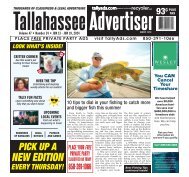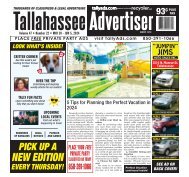070122_TT_AllPages
You also want an ePaper? Increase the reach of your titles
YUMPU automatically turns print PDFs into web optimized ePapers that Google loves.
THETRUCKER.COM JULY 2022 • 21<br />
FOCUS cont. from Page 15<br />
A Level 2 inspection includes everything<br />
in the Level 3 check — plus a “walk-around”<br />
inspection of the vehicle. Most of what the<br />
inspector looks at in a Level 2 should have<br />
already been inspected by the driver in that<br />
day’s pre-trip inspection. Tires and wheels<br />
are one focus of the inspector, who looks for<br />
flat or underinflated tires, loose lug nuts,<br />
broken rims and other obvious problems.<br />
A common violation is “chafing” air lines,<br />
either behind the tractor or underneath<br />
the trailer. Obvious issues, such as air<br />
leaks, inoperative lighting and fifth-wheel<br />
attachments, are easy for inspectors to<br />
check.<br />
All too often, pre-trip inspections turn<br />
out to be paper exercises that don’t identify<br />
issues often found by inspectors. Of course,<br />
it’s possible for a tire to lose air or even go<br />
flat without the driver’s knowledge, but<br />
routine inspections will catch many issues<br />
that inspectors end up writing up.<br />
The Level 1 inspection is the most<br />
comprehensive, featuring a complete vehicle<br />
inspection around and under the unit,<br />
along with everything included in the Level<br />
2 inspection. This is where the inspector<br />
literally gets down to the nuts and bolts.<br />
Brakes, steering, suspension, fifth-wheel (if<br />
equipped) — it’s all checked. You may be<br />
asked to participate in the inspection by<br />
turning lights on and off, applying the brake<br />
pedal or other actions as directed.<br />
Some inspectors will conduct the<br />
inspection and hand you the form, while<br />
others will take the time to point out each<br />
violation and explain why they wrote it up.<br />
While many drivers consider inspections<br />
to be the heavy-handed application of<br />
regulations by law enforcement agencies,<br />
the reality is generally quite different.<br />
The inspection criteria are developed by<br />
the Commercial Vehicle Safety Alliance<br />
(CVSA), which is a partnership between<br />
government agencies, manufacturers and<br />
trucking community members. At regularly<br />
scheduled meetings, experts discuss and<br />
decide the criteria used to determine if<br />
a part, for example, a slack adjuster on<br />
a braking system, is within specs, out of<br />
spec but not shutdown-worthy or calls for<br />
immediate shutdown.<br />
Passing a DOT inspection is much<br />
more likely if you perform regular pretrip<br />
inspections and quickly having<br />
any discrepancies you find repaired.<br />
Supplement these inspections with periodic<br />
walk-arounds as you stop for breaks or other<br />
reasons. A quick check of lights and tires<br />
and help you identify issues early, rather<br />
than waiting for the next pre-trip.<br />
Checking your permit book — or bringing<br />
it to the office of the carrier you drive for<br />
periodically for review — helps you stay up<br />
to date. Keeping it organized by replacing<br />
expired permits with new ones and keeping<br />
it neat and orderly helps.<br />
Keep your load paperwork together<br />
in one place, and keep it neat. If you haul<br />
hazmat, the hazmat paperwork must be on<br />
top or tabbed for quick identification, and it<br />
must be left on the driver’s seat or in a door<br />
pouch when you exit the vehicle.<br />
Stay informed. Often, inspection<br />
initiatives are focused on a particular item<br />
such as brakes, and many are announced<br />
in advance. While this doesn’t mean you<br />
can ignore other systems or items, it can<br />
help make sure you address what you know<br />
inspectors will be looking for.<br />
Finally, your attitude matters. The<br />
inspector is doing a job, just as you are,<br />
and that person in uniform is also a human<br />
being. Expressing your frustration at<br />
being stopped, arguing about violations<br />
and generally being difficult won’t help<br />
you pass. Being polite and respectful can<br />
make a difference and marks you as a<br />
professional. Arguing with the results won’t<br />
get you anywhere, but politely asking for<br />
clarification might.<br />
If you know your vehicle is mechanically<br />
sound and your paperwork is in order before<br />
you start your day, your chances of passing<br />
a DOT inspection increase and your day just<br />
might go better. 8<br />
Courtesy: CVSA via Facebook<br />
During a Level 2 roadside inspection, officials conduct a “walk-around” inspection of the vehicle. Most of the items<br />
checked should have already been inspected by the driver during the trip’s pre-check.. A Level 3 inspection deals<br />
with the driver and compliance with the rules. The inspector will look at the driver’s CDL to determine that it’s valid<br />
and is appropriate for the vehicle driven and the cargo being hauled.<br />
SAFETY cont. from Page 15<br />
out how to make that lane change in heavy<br />
traffic, remember that the driver behind your<br />
vehicle also wants to change lanes, and the<br />
driver overtaking you in the lane needs to be<br />
prepared for your maneuver. It’s important to<br />
know what’s going on all around and to anticipate<br />
the poor decisions of other drivers.<br />
Finally, never allow impatience to dictate<br />
your driving decisions. It’s easy to get frustrated<br />
when attempting a turn or maneuver<br />
when traffic isn’t cooperating. There is no<br />
“long enough” when it comes to waiting for<br />
a safe opportunity. Don’t let frustration make<br />
driving decisions for you.<br />
It helps to remember that your driving<br />
decisions beget decisions by other motorists.<br />
Your lane change, for example, can result in<br />
those behind you also making lane changes<br />
or changing speed in order to keep from being<br />
behind you. Armed with that knowledge,<br />
you can make better decisions that help<br />
make the roads safer for everyone.<br />
Stop for a minute and think about professional<br />
auto racers. During many races, the<br />
participants drive in ways that would be considered<br />
extremely dangerous on the highway.<br />
They drive aggressively at excessive speeds,<br />
intentionally tailgating the vehicle in front.<br />
When crashes occur, they can be spectacular,<br />
yet some races feature hundreds of miles<br />
of driving with few or even no crashes. Why?<br />
As long as everyone is going the same<br />
speed and direction, crashes don’t usually<br />
happen. When someone changes direction,<br />
pulling out to pass or perhaps trying to<br />
quickly get to the pit lane, it creates a hazard<br />
for everyone. Changing speeds, by accelerating<br />
or by slowing due to a vehicle problem,<br />
also creates risk on the track.<br />
There’s a parallel in highway driving. If<br />
everyone is traveling the same relative speed<br />
and staying in their lane, things are safer. Let<br />
someone slow down or change lanes, however,<br />
and the risk of an accident rises.<br />
If you must drive aggressively, make sure<br />
you do it defensively. 8<br />
LOVPB-0055_052722_5125x375_V1_L1.pdf 1 5/27/22 10:27 AM Marketplace<br />
FOR<br />
ADVERTISING INFO EMAIL MEGL@THETRUCKERMEDIA.COM<br />
HOW WE HELP<br />
C<br />
M<br />
Y<br />
CM<br />
MY<br />
CY<br />
MY<br />
K<br />
Provide financial assistance<br />
to Class A, OTR drivers for<br />
essential household expenses<br />
when an illness or injury has<br />
recently taken them off the road<br />
Provide health & wellness<br />
programs like Rigs Without Cigs<br />
to prevent common diseases<br />
and to encourage healthy habits<br />
WITH<br />
DRIVERS<br />
HELPED<br />
MILLION<br />
PAID<br />
DIRECTLY TO THEIR BILL HOLDERS<br />
FOR HOME, UTILITIES, VEHICLE<br />
AND INSURANCE<br />
SUPPORT THE INDUSTRY. SUPPORT DRIVERS.<br />
DONATE TODAY.<br />
TRUCKERSFUND.ORG<br />
CONNECT WITH US<br />
@TRUCKERFUND

















